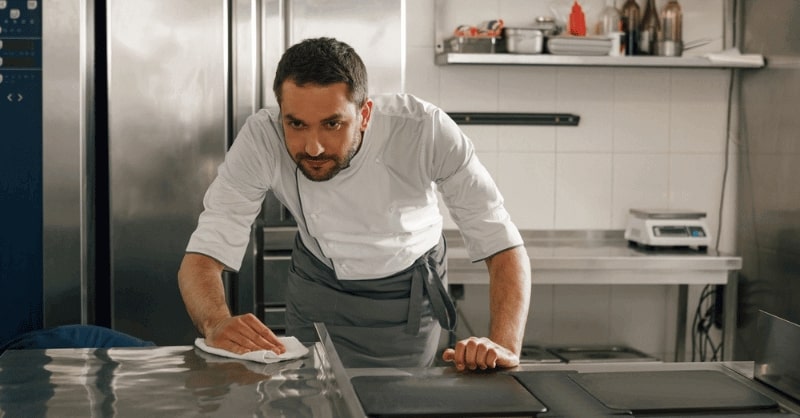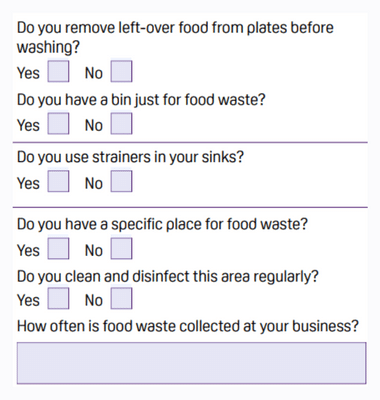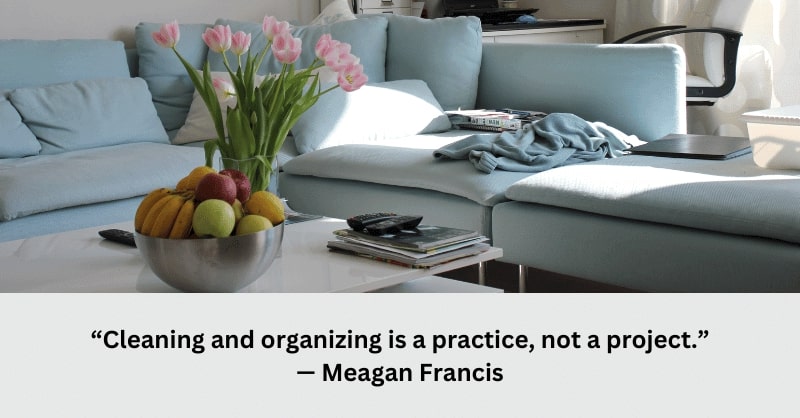Did somebody tell you that you should “clean as you go,” and you have no clue what they’re talking about? It means you’re expected to clean up after yourself immediately following every task. So, clean as you go – the name itself is self-explanatory.
If you’re prone to procrastinate or want to become more efficient, try this method for a few weeks and see how it transforms your life.
In this blog, you’ll learn –
Table of Contents
What is Clean As You Go?
Clean as you go is a cleaning technique. It helps to improve hygiene, health, and safety. This method involves cleaning continuously throughout the working day. It means cleaning will become a part of your daily routine. Clean as you go method ensures that all surfaces, equipment, premises etc., are clean, sterile, and clutter-free all the time.
What is a “Clean as you go” policy? The clean as you go policy places the responsibility, to maintain the work environment and keep a clean, tidy and safe condition, on all employees at all times while carrying out duties on the premises. The ‘clean as you go’ or, in short, ‘CLAYGO’ policy is standard cleaning practice in the food industry. It’s one of the simplest and most reliable methods of meeting the food hygiene standards required by the Environmental Health Office (EHO).
What is claygo?
Claygo stands for Clean As You Go. It’s a practice commonly used in households, restaurants, and workplaces where individuals clean up after themselves as they go along with their tasks to maintain cleanliness and tidiness.
Benefits of Claygo:
♦ Helps maintain a clean and organized environment
♦Reduces the accumulation of dirt and clutter
How Does Claygo Work?
‘Clean as you go’ is a mindset rather than a chore. It’s a habit of constant cleaning and decluttering.

The primary areas for concern in clean as you go are:
- Workstations should be clean, safe and tidy
- Tools, and equipment will be put away right after use
- Floors will be kept clear of waste, plastic, or stray toys/tools etc.
- Waste and plastic is to be baled or recycled as soon as possible
- Boxes and other unnecessary things will not be cluttered
- All walkways should be clean and clear at all times
- All outer packaging will be removed and disposed of straight after use
- Waste bins must be emptied regularly
- All waste and rubbish will be kept away from food and common areas
But immediate cleaning isn’t something you micromanage. That’s why you have to train your staff properly. And only then can you expect them to know how to react when a hazardous spill or breakage occurs. All staff members, including current and new ones, should be familiar with the CLAYGO policy.
Hazard signs help to warn staff members, customers, and visitors that the area poses certain risks. And responding quickly to cleaning incidents is essential. But this won’t be possible if a staff member has to search for the kit or if it’s located too far away.
Also, make sure that schedules are appropriate for your workplace’s conditions and needs. Please note that the Environmental Health Officer values training in cleaning.
What is Clean As You Go Sign?
A clean as you go sign serves as a visual prompt to encourage individuals to tidy up their workspace or environment as they go about their tasks. This practice promotes cleanliness, organization, and efficiency by reminding people to address messes or spills promptly rather than letting them accumulate and become more difficult to clean later on. Benefits of implementing a clean as you go approach include:
♦ Maintaining a hygienic and orderly environment
♦ Increasing productivity by minimizing distractions caused by clutter
♦ Promoting safety by promptly addressing spills or hazards
♦ Fostering a culture of responsibility and cleanliness among individuals
Clean As You Go Examples
Here are some examples of ‘clean as you go’ in daily life:- Take out the trash when it’s full.
- Immediately clean up spills or broken things
- Wipe down the washbasin after brushing your teeth.
- Load dirty dishes in the dishwasher immediately after using them.
- Pick up and put things in their designated place when you see them.
Why is it Important to Clean as You Go?
We all know cleanliness is important. But why should we care about ‘clean as you go’? Well, here’s why –Promote a Healthier, Happier Workplace
Establishing a culture of cleanliness in the workplace is quite challenging. That’s because different people have different habits. But if you are able to establish CLAYGO effectively, you can make people more responsible for their messes. This is a good alternative to paying the cleaning crew to clean up after people. And with time, cleaning will become a part of the organisation’s culture. The outcome will be a cleaner, healthier workplace where people can thrive with good hygiene and health. And this, in turn, increases employee morale and job satisfaction.Lower Risk of Accidents and Injuries
A cluttered, unclean workplace can cause plenty of minor accidents and injuries. For instance, it can cause slips, trips, and falls. This can result in bumps, cuts, bruises and, in some cases, broken bones or worse. Luckily, we can prevent many of these accidents by practising the clean as you go method.Improved Productivity
Employees tend to be more efficient and productive in a safe and clutter-free workplace. Focusing on work is easier when you aren’t concerned about their health and welfare. Also, an employee’s productivity directly correlates with their safety and happiness at work. Besides, practising ‘clean up as you go’ is actually less time-consuming than leaving the chore for later. And this means employees can allocate more time for more meaningful tasks. “For every minute spent on organizing, an hour is earned.” — Benjamin FranklinEnsure Compliance
The UK has several laws and regulations in place to ensure that every person remains healthy and safe in their workplace. For example, Health and Safety at Work etc Act 1974 covers occupational health and safety in Great Britain. It covers a variety of things, including cleanliness, hygiene and safety programmes. It’s easier to ensure health and safety for everyone in the workplace with the CLAYGO policy. It positively impacts employee morale and encourages a participative culture while ensuring compliance.What are the Two Types of Cleaning Categories?
Cleaning categories can be broken down into two types—urgent and non-urgent cleaning.Urgent Cleaning
Urgent cleaning is needed to prevent an immediate health or safety risk, such as spillage or breakage. For example, suppose you broke a mug in the hallway. If you don’t pick up all the broken pieces instantly and clean them properly, someone might get hurt by them. Responding immediately to spillages and breakages is crucial for risk management and safety. People might slip and fall, which might lead to breakage, cuts and serious injuries. That’s why you must ensure complete safety at all times. We recommend keeping a safety and cleaning equipment kit for such unfortunate events.
What to Include in an Urgent Spill Cleaning Kit?
A spill-cleaning kit should include the following things:
- Disposable gloves.
- Absorbent paper
- Disinfectant or cleaning spray.
- Absorbent cloths or sponges.
- Bin and bin bags for the debris.
- Broom, brush and dustpan.
Your urgent spill-cleaning kit should be placed in an easily accessible place. Also, you should identify the common areas where these spillage or breakage accidents commonly occur. So, cleaning kits should be available in those areas.
Non-Urgent Cleaning
Non-urgent cleaning refers to day-to-day maintenance to keep the workplace safe and clean. This type of cleaning may include cleaning surfaces, sweeping floors, emptying bins or rubbish cans and other similar things.

This type of cleaning routine is necessary to keep the premises clean and hygienic. Non-urgent cleaning may include the following and more –
- keeping surfaces clean and free from germs and bacteria,
- clearing away rubbish
- emptying bins,
- cleaning the floors
- making sure that equipment is clean and ready for subsequent use.
Your non-urgent cleaning kit should contain everything you need. For example, antibacterial sanitisers, disposable cloths, mop and bucket, vacuum cleaner etc.
Please note that your non-urgent cleaning routine will depend upon the industry and your workplace.
Why is it Important to have a Clean as You Go Policy?
The clean as you go policy is a standard working practice throughout the food industry and is also important in retail, hospitality and other relevant sectors.
Cleaning in our home and at the workplace varies a lot. It’s easy to understand clean as you go in a domestic setting – use the correct cleaning materials and keep all surfaces clean. But when it comes to the workplace, such as a kitchen, all tasks have to be catered for. That’s why cleaning at work requires a foolproof, well-thought-out policy and clear instructions.
Formal, written policies will help all staff members know exactly what to do and that it’s everyone’s responsibility to act on them. Without specific guidelines, staff members tend to believe that cleaning is someone else’s job and may just leave it for someone else to do it for them!
What to Cover in the Clean As You Go Policy?
When you’re making a clean as you go policy, it’s important to ensure that your policy covers all the essentials. Here are a few important things that you must include in your policy.
- All the essential daily tasks, including urgent and non-urgent cleaning tasks. For example – cleaning floors at the end of the shift and disposing of rubbish.
- Right placement of cleaning tools and spill-cleaning kits with regular check-up times to ensure there’s no shortage.
- A time sheet that staff members need to sign off after scheduled, non-urgent cleans.
- A full range of cleaning equipment with proper cleaning instructions.
- Placing dirty rugs or equipment in the washing machine or the right container to be taken away by cleaners.
How to Establish Your Clean as You Go Policy?

Having a formal clean as you go policy at work is important, so all staff members know their duties. A clean as you go policy must include clear instructions and everything necessary – from wiping down dirty surfaces to cleaning the floors and emptying the bins.
But this is just common sense; why do you need to establish a formal clean as you go policy? Because it’s helpful for staff members, especially new or younger employees who may need more confidence about taking the initiative. Also, having clear guidelines and knowing the importance of a constant cleaning routine will help establish a healthy working environment for everyone.
Before you establish the policy, here are some other important considerations to implement it efficiently:
- The time for essential cleaning tasks
- The correct disposal of waste and when it’s to be disposed of
- The ideal placement of standard cleaning equipment and spill kits
- The first concern areas, such as food preparation surfaces or walkways and public areas
- The proper use of cleaning materials
This is not comprehensive. But it should be able to guide your clean as you go policy implementation.
Also, your daily cleaning policy should clearly outline the ‘who, when and what’ mentioned in your daily schedules. And you could also put someone ‘on duty’ to respond to immediate spills or messes. In case you have a large premise, you should have someone exclusively on cleaning duty in each area to make it clear who’s responsible for it.
It should also be mentioned that any downtime or quiet periods spent on routine cleaning will be noted favourably. Conversely, failing to clean and use time productively are negative indicators.
Yes, different businesses and industries have different requirements, but the basic message is the same.
- Every business aims to keep the area clean and hygienic.
- Every business wants to deal with emergency cleaning situations as and when they happen.
In a nutshell, short and pointed reminders, consistently enforced, are likely to stand the test of time. So, if you repeat it enough, it begins to stick – “clean as you go.”

How to Manage Your Clean As You Go Policy?
Once you’ve established your CLAYGO policy, you need to make sure that it’s effectively reviewed and managed. If you see any inconsistencies or lack of implementation, you need to do the following.
- Review your clearing and cleaning practices
- Reconsider the order or timing of tasks to keep surfaces clear and clean easily
- Review staffing levels
- Train staff again, if necessary
- Improve staff supervision
- Offer recognition and incentives
Clean As You Go Restaurant
Cleaning as you go in a restaurant is essential for maintaining a hygienic environment and ensuring smooth operations. Distributed leadership, as described in the provided article, emphasizes the decentralization of decision-making and responsibility. When applied to a restaurant setting, this means that every member of the staff, not just the managers or designated cleaners, shares the responsibility of keeping the space clean.
Here’s why cleaning as you go is crucial in a restaurant:
– Hygiene: Regular cleaning prevents the buildup of dirt, grease, and bacteria in the kitchen, dining area, and other spaces. This helps to maintain food safety standards and reduces the risk of contamination, which is vital for the health of both customers and staff.
– Efficiency: Cleaning as you go ensures that tasks are tackled promptly and efficiently throughout the day. Instead of letting messes accumulate and tackling them all at once, cleaning as you go allows for continuous maintenance, saving time and effort in the long run.
– Customer Experience: A clean and tidy environment enhances the dining experience for customers. It shows that the restaurant cares about cleanliness and attention to detail, which can leave a positive impression and encourage repeat business.
– Safety: Keeping walkways, kitchen floors, and other areas clear of spills and debris reduces the risk of accidents such as slips and falls. This is crucial for both staff safety and avoiding liabilities for the restaurant.
– Teamwork and Responsibility: Implementing a culture of cleaning as you go fosters teamwork and a sense of shared responsibility among staff members. When everyone contributes to maintaining cleanliness, it creates a more cohesive and efficient work environment.
cleaning as you go aligns with the principles of distributed leadership by empowering every member of the restaurant staff to take ownership of maintaining a clean and hygienic space. It promotes accountability, teamwork, and efficiency, all of which are essential for the success of a restaurant.

What Does Clean As You Go Mean in the Kitchen?
Keeping your industrial or home kitchen clear and clean makes it a lot safer for you or anyone who goes or works there. Here are a few safety points for anyone who wants to apply clean as you go policy in kitchens.
Be Careful with Outer Packaging
You must take off the outer packaging of food and throw them away before you bring food into the kitchen or storeroom. This is because outer packaging could have touched dirty surfaces when stored or transported.
Also, you should take extra care while throwing away raw food packaging and food waste. For example, if packaging from raw food touches work surfaces, they need washing and disinfecting afterwards. In addition, packaging and food waste from these can spread harmful bacteria and allergens to food and other surfaces.
Keep Your Kitchen Free from Clutter and Rubbish
Clearing away dirty kitchen equipment instantly is always a good idea. Work surfaces are more manageable and easier to keep clean when things are not scattered. Also, clearing away used equipment helps prevent bacteria and allergens from spreading to surfaces or food.
Keep Sinks Clear and Clean Them Regularly
Always keep your sinks clean. This will stop dirt and bacteria from building up. Regular cleaning will prevent bacteria and allergens from spreading.
Wash or Wipe Away Spills Instantly
As soon as something spills, clean and disinfect work surfaces after wiping it up. This is more important when it comes to spills from raw food. It prevents the spread of bacteria and allergens.

Clean As You Go Rules
Clean as you go is a principle often applied in various contexts, from cooking to workplace environments. It essentially means maintaining cleanliness and organization as you work or go about your tasks, rather than leaving a mess to clean up later. This principle can be extended to distributed leadership, where each member of a team takes responsibility for their actions and their impact on the overall functioning of the team. In a distributed leadership model, individuals proactively address issues, contribute their expertise, and collaborate with others to achieve common goals. Just as one would clean up after themselves in a shared space to maintain order and efficiency, distributed leadership emphasizes accountability, initiative, and collective responsibility for the success of the team or organization.
– Accountability
– Initiative
– Collective responsibility
Wash Work Surfaces Thoroughly Between Tasks
It’s a good idea to clean work surfaces in between tasks. But a dirty cloth could spread bacteria and allergens to the surface. So, you should use a new cloth or a cloth that’s been washed and disinfected to clean work surfaces. For example, you should clean the work surface before you make ready-to-eat food. It will help prevent dirt and bacteria, and allergens from spreading onto other foods from the surface.
Manage Food Waste Efficiently
Food waste management in the kitchen can prevent fat, oils, and grease from blocking sinks, pipes, and drains. Besides, food waste can contaminate food preparation areas with bacteria and allergens.
- Scrap food waste into the bin before washing anything. We recommend using a separate bin just for food waste. As this will help prevent food from blocking pipes and drains.
- Use a strainer over the plughole in the sink to stop food from going down the pipe. That’s because it will help prevent food from blocking your sinks, pipes, and drains.
- Food waste must be kept in a specific place before it is collected, ideally away from food preparation. And that area should be cleaned and disinfected regularly.
- Regular collection of waste is essential. If waste isn’t disposed of regularly, it can smell, attract pests and increase food safety risks.
You can use the following resource to ensure proper food waste management in the kitchen.

Besides, you can check with the environmental health department if your area has specific requirements.
Clean As You Go in Workplace
The Clean as you go policy applies to all employees. This policy ensures that workplace cleanliness and hygiene are maintained to the highest standard. The workplace’s safety and appearance will be maintained, providing a safe, legal, and hygienic work environment.

Simple things like closing cabinet doors correctly and picking up clutter can drastically minimise the risk of accidents. In addition, when employees feel safe in the workplace, they’ll be happier and more confident. It can also help you become your most efficient self at work.
Here’s how you can apply the clean as you go method to work:
- Immediately respond, file or delete emails after receiving them.
- Do the most challenging work tasks at the beginning of each day.
- Do work tasks on time instead of saving them for later.
How to Use “Clean As You Go” to Keep a Clean House?
If you struggle with keeping a clean house because of work or babies at home, clean as you go is here to save the day. Not only that, it can save you a lot of time in cleaning and help you keep a tidy house with little effort.

The clean as you go method is the most used strategy to keep a house clean. And it helps avoid massive messes since you’re constantly cleaning up after yourself. Also, it’s a cleaning strategy for any who is prone to procrastinate.
Here’s how you can keep your house clean with clean as you go method.
- Take out the trash when you see that it’s full.
- Wipe down your bathroom sink after you use it.
- Load dirty dishes in the dishwasher immediately after using them.
- Pick up and put away stray toys or things when you see them.
- Do laundry as soon as you have enough for a load.
- Put away laundry as soon as you’ve finished folding.
- Wipe down food prep messes as food cooks.
So, the clean as you go principle is just simple, yet effective actions that prevent your house from becoming a disaster.
As a bonus, CLAYGO can point you to other risks you may not have noticed otherwise. It can be small, like a loose floor tile or a broken office door hinge. Even better, this can help you save money because you can prevent such issues from worsening.
How do You Learn to Clean as You Go?
Learning clean as you go is more about adopting a mindset. Whenever you see a mess or spill, you clean it up. You see a cabinet door not closed properly, and you close it, so someone doesn’t get hurt. It’s that simple!
You can also opt for formal training to ensure your learning is up to standard and receive an internationally recognised certificate. Here are a few excellent courses from One Education that’ll cover all the essentials of cleaning, and you can apply them in other areas of life too.
FAQs About Clean As You Go
Find answers to the most asked questions about ‘cleaning as you go’ below.
1. Do businesses use the clean as you go method?
Yes, clean as you go method is used in many businesses where urgent cleaning is necessary. In fact, many fast-food chains and restaurants use this method. And it’s proven to be very valuable for compliance with food and safety laws and regulations. It’s also a common method used in the hospitality industry and medical premises.
2. Can I apply the clean as you go method to other areas of my life?
Yes, cleaning as you go method can be applied to any part of your life. You can use it in your personal life and professional life. And you’ll be able to avoid procrastination and get more done.
3. Why cleaning is important?
Cleaning is important because it helps maintain hygiene, prevents the spread of germs and diseases, and creates a safe and pleasant environment. It also enhances productivity and efficiency.
4. What does clean as you go mean in the kitchen?
Clean as you go in the kitchen means tidying up and washing dishes, utensils, and surfaces immediately after using them, rather than letting them pile up and create a mess. It’s about maintaining cleanliness and orderliness throughout the cooking process to make cleanup easier and more efficient.
4. Which one of the following is the primary reason for the practice of clean as you go?
The primary reason for the practice of clean as you go is to maintain cleanliness and prevent accidents in the workplace. It involves cleaning up spills and messes immediately to ensure a safe and hygienic environment for everyone.
6. What are the 7 clean as you go tools?
Clean as you go tools include dish soap, spray bottles with disinfectant, sponges, microfiber cloths, scrub brushes, rubber gloves, and trash bags.
Summary

The simplest way to keep your space clean is to hire commercial cleaning businesses. But it definitely pays to have your entire staff be part of a cleanliness culture, especially in the food and hospitality industry. And it’s always a net positive when everyone works towards a common goal.
CLAYGO is an excellent tool for sparking a sense of initiative and teamwork in the workplace. If you haven’t implemented this policy yet, perhaps it’s time to try it out.
If you need to practise cleanliness and hygiene in your personal life to keep your house clean, it’s a great method to take back control of your life. Let this House-cleaning course guide your habits toward a tidier and happier home.







 March 06, 2023
March 06, 2023








